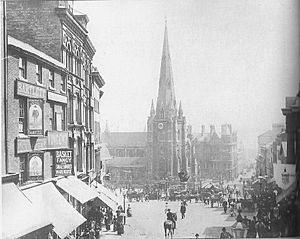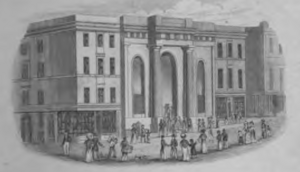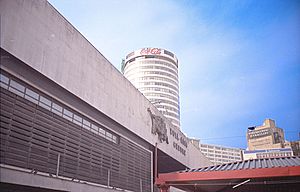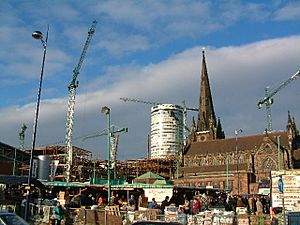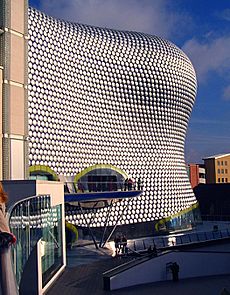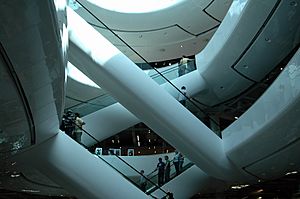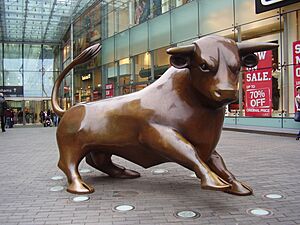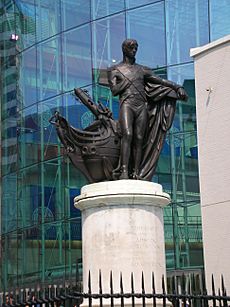Bull Ring, Birmingham facts for kids
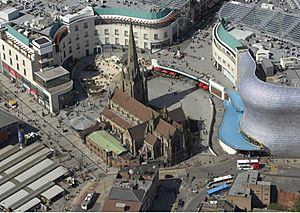
The Bull Ring in 2011
|
|
| Location | Birmingham, England, UK |
|---|---|
| Coordinates | 52°28′39.72″N 1°53′39.04″W / 52.4777000°N 1.8941778°W |
The Bull Ring is a huge shopping area in central Birmingham, England. It has been an important place for shopping since the Middle Ages, when its market first started. Two large shopping centres have been built here. The first was in the 1960s, and the second opened in 2003. The newer centre is called Bullring (one word).
When the Bullring is joined with Grand Central (which is connected by a special bridge called 'LinkStreet'), it becomes the biggest city centre shopping area in the United Kingdom. It's known as Bullring & Grand Central.
The area is on the edge of a sandstone ridge. This means the ground slopes quite a bit, dropping about 15 metres (50 feet) from New Street down to St Martin's Church. You can easily see this slope near the church.
In 2004, the current Bullring shopping centre was the busiest in the UK, with 36.5 million visitors! It has one of only four Selfridges department stores in the country.
Contents
What's in a Name?
The area was first called Corn Cheaping. This name came from the corn market that used to be there. The name Bull Ring came from a green space within Corn Cheaping. This space was used for bull-baiting, which was a cruel sport where bulls were tied to an iron ring and attacked by dogs before being slaughtered.
When the new shopping centre was built in the 21st century, the name was changed to "Bullring" (one word). This caused some people to be upset because they felt it changed a "historic spelling."

A Look Back in Time
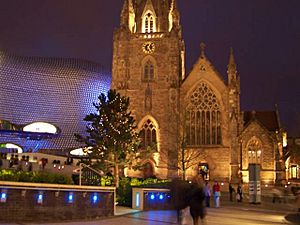
The market officially started in 1154. This happened when Peter de Bermingham, a local landowner, got a special permission called a Charter of Marketing Rights from King Henry II. At first, people traded textiles (cloth) in the area. By 1232, records show a merchant who owned weavers, a smith, a tailor, and a food supplier. Within ten years, the area grew into a major market town, especially for cloth.
The street name Mercer Street first appeared in 1553. This showed how important the cloth trade was there. In the 16th and 17th centuries, Mercer Street became very busy and crowded. By the early 1700s, it was called Spicer Street, because the grocery and meat trades were growing more than the cloth trade. Later, it became Spiceal Street. Even though it was crowded, many houses still had gardens. Houses were built very close to St Martin's Church, eventually surrounding it. These were known as the Roundabout Houses.
A map from 1731 shows other markets nearby, including food, cattle, and corn markets. The corn market later moved in 1848. As Birmingham grew into a big industrial city, the Bull Ring became its main market area.
The High Cross was an important building for public meetings in the Bull Ring. It was last worked on in 1703 and was taken down in 1784. It was also called the Butter Cross because farmwives sold dairy products under its arches.
In the 1830s and 1840s, the Bull Ring was a popular spot for large gatherings and speeches from leaders of working class groups. In 1839, some disorderly events happened here, causing damage to property. This made people worry about the local council's ability to keep order. Because of bad behaviour at fairs, in 1861, the Bull Ring became one of the few places in central Birmingham where fairs were allowed. However, by 1875, all fairs were banned from the town.
By the Victorian era, many shops were open around the market. Immigrants started businesses like selling flowers and umbrellas. The Lord Nelson statue became a place for public speaking and discussions.
Markets in the Bull Ring
In the late 1700s, city officials decided to buy and knock down houses in the town centre, including those around the Bull Ring. They wanted to bring all market activities to this one area. This was because new markets were popping up everywhere, causing lots of traffic. Demolition started slowly, but after 1801, it sped up. By 1810, all properties in the area were cleared. Small streets like The Shambles and Corn Cheaping were removed. The Shambles was a row of butchers' shops, near where bulls were slaughtered.
A large open space in front of St Martin's Church became the marketplace. The city officials decided they needed a covered market hall. They bought the market rights and by 1832, almost all properties were bought. To pay for the land, two buildings were built next to the market hall and rented out.
Construction of the Market Hall began in 1833. It was designed by Charles Edge, who also designed Birmingham Town Hall. It cost about £20,000 and opened on February 12, 1835. It had 600 market stalls. The building was grand, made of stone from Bath, Somerset. Two large columns stood at each wide entrance. At the end of the day, metal gates closed the entrances.
In the middle of the large hall was a beautiful bronze fountain. It was given by the city officials in 1851. The fountain was 6.4 metres (21 feet) tall. It had a statue of four children, representing Birmingham's main industries: gun making, glass-blowing, bronzing, and engineering. The fountain was removed in 1880 and later destroyed in 1923.
Gas lighting was added to the building, which meant the market could stay open longer. A special clock with figures was also installed. This clock was destroyed when the Market Hall was hit by an incendiary attack on August 25, 1940, during World War II.
In 1869, a fish market was built. In 1884, a covered vegetable market was also completed. Horse trading was very popular here in the 1880s, with over 3,000 horses for sale. But this trade quickly declined, and the last horse fair was in 1911.
Much of the Bull Ring survived World War II, though nearby New Street was heavily bombed. Shops sold tax-free items to encourage people to buy things, as goods were hard to find even after the war. Woolworths became a very popular shop on Spiceal Street. The old Market Hall remained as an empty shell and was used for small exhibitions.
What We Found Underground
When the new Bullring was being built in 2000, archaeologists dug up the site. They found things dating back to the 12th century! They discovered a ditch where the Selfridges store and Park Street car park are now. This ditch was a boundary separating houses from a deer park. Rubbish found in the ditch included broken pottery, showing that pottery kilns were there in the 13th century.
Many leather tanning pits from the 17th and 18th centuries were found. These pits held pieces of crucibles, which are pots used to melt metal. The leftover bits in these pots showed alloys of copper with zinc, lead, and tin. More leather tanning pits from the 13th century were found where the Indoor Markets are now.
Burials from the 18th and 19th centuries were also found in the churchyard of St Martin's. You can find four information panels in the Bullring that tell you more about these discoveries and the history of the site.
The First Bull Ring Centre
In 1955, shops started closing as plans for a new Bull Ring began. The plans included new roads and knocking down all old buildings. Many companies offered ideas, but Birmingham City Council chose the plans from John Laing & Sons. Demolition started in the late 1950s with the old fish market. Construction began in the summer of 1961.
The outdoor market area opened in June 1962, with 150 stalls. The rest of the new Bull Ring was still being built.
In 1964, the Birmingham Bull Ring Centre was almost finished. It had both traditional outdoor market stalls and a new indoor shopping centre. This was the first indoor city-centre shopping centre in the UK! It was opened by Prince Philip, Duke of Edinburgh on May 29, 1964, and cost about £8 million. The shopping centre covered 23 acres and had 350,000 square feet of shops. Soon after it opened, Queen Elizabeth II visited.
The Bull Ring Bus Station was on the lower level of the shopping centre. The market area was below ground and had about 150 stalls, mostly selling food. It was split by a large road that connected to the inner ring road. There was direct access to New Street station and easy access from Moor Street station. A multi-storey car park with 500 spaces was also part of the complex. People could reach roads by walking through a network of underground passages.
A nine-storey office block was also built. It was attached to the car park. The shopping centre had 140 shops, 19 escalators, 40 lifts, and was air-conditioned with music playing.
The remains of the old Market Hall were knocked down in 1963. They were replaced by Manzoni Gardens, an open space for shoppers to relax. In the 1970s, a statue of King Kong even stood there! A mural of a bull was on the side of the building.
The 1960s Bull Ring Centre had problems from the start. It was considered very modern when it opened. But higher rents meant traders didn't want to be there. People also didn't like using the underground passages and escalators, which often broke down. The building didn't age well and soon looked old and grey. It was disliked by the 1980s and made people think Birmingham was just a "concrete jungle."
In 2015, Historic England listed four bull murals that were on the outside walls of the shopping centre as lost or destroyed.
The New Bullring
| Location | Birmingham, England, UK |
|---|---|
| Opening date | 4 September 2003 |
| Developer | The Birmingham Alliance |
| Management | Tim Walley |
| Owner |
|
| Architect | Benoy |
| No. of stores and services | 140 |
| No. of anchor tenants | 3 (Marks & Spencer, Selfridges, TK Maxx) |
| Total retail floor area | 1,585,000 square feet (147,300 m2) |
| No. of floors | 4 (3 accessible from outside) |
| Parking | 3,100 |
Planning the New Centre
Plans for a new Bull Ring started in the 1980s. In 1987, the first serious plans were released. They suggested knocking down the old Bull Ring Shopping Centre completely. They wanted to build a huge new mall. A group called Birmingham for People was formed to help with the redevelopment. They gave out leaflets to 44,000 homes. But because of public opinion, the plans had to be changed.
In 1988, new plans showed many buildings with a wide pedestrian street leading to St Martin's Church. Two tall buildings, similar to the Rotunda, were also suggested. However, these plans didn't happen due to a lack of local support. In 1995, the plans were changed again, but a retail slowdown meant construction couldn't start.
Building the New Bullring

After earlier plans failed, new ideas came up in the mid-1990s. These plans gained support and a masterplan was published. However, changes were made to the design soon after. In 1998, Selfridges considered opening a store in Glasgow instead of Birmingham. This was a big deal for Birmingham's planned redevelopment.
The successful plan got permission, and demolition of the 1960s Bull Ring Shopping Centre began in 2000. The market traders moved to the Rag Market. The new design mixed traditional market activity with modern shops. The main builder was Sir Robert McAlpine. The first building finished was the Nationwide Building Society.
The new indoor shopping centre, "Bullring," opened on September 4, 2003. Because a major road and two railway tunnels run under the site, two levels of shops are cleverly hung from four huge steel arches. These arches weigh 120 tonnes each!
The first week was incredibly busy. On opening day, September 4, 2003, about 276,600 people visited the shopping centre.
Design and Look
The Bullring Shopping Centre was designed mainly by Benoy. It has two main buildings (East and West Mall). They are connected by an underground passage with shops. You can also get to them from St Martin's Square through glass doors. A glass roof called the SkyPlane covers 7,000 square metres (75,000 sq ft) and seems to float without visible support.
The two malls look different inside. The East Mall has glass 'jewels' in its metal railings. A very famous building houses the Selfridges department store. It was designed by Future Systems architects. The store is covered in 15,000 shiny aluminium discs, inspired by a Paco Rabanne sequinned dress. The Selfridges store cost £60 million and has won eight awards, including the RIBA Award for Architecture in 2004.
There's a multi-storey car park across from Selfridges. It's connected to the store by a 37-metre (121 ft) long, curved, covered bridge.
In 2005, a small Costa Coffee café was built near the steps leading to New Street. It was shaped like a shell with a curved bronze roof. This café was knocked down in 2011 as part of the Spiceal Street redevelopment.
The Bullring's design has both fans and critics. In 2008, a poll said it was the "ugliest building in the country," but this poll was also criticised.
Spiceal Street
On September 6, 2010, plans were announced for a 20,000 square foot expansion. This included three new restaurants in St Martins Square. Existing restaurants like Pizza Hut and Nandos were also made bigger. The new restaurants included 'Browns Bar & Brasserie' and 'Chaobaby'. The third unit became 'Handmade Burger Co'. Along with Wagamama and Jamie's Italian, this created a hub of seven restaurants named after the traditional Spiceal Street. Construction began in March 2011, and the new Spiceal Street opened on November 24, 2011. Since then, some restaurants have changed, like Jamie's Italian being replaced by Vietnamese Street Kitchen.
Art Around the Bullring
There are many artworks around the Bullring:
- A large glass mural by artist Martin Donlin faces the entrance to Birmingham New Street station.
- Three tall 'light wands' stand in Rotunda Square. They sway in the wind and reflect light, especially at night when they glow blue, green, and red.
- At the main entrance to the west building is The Guardian. This 2.2-metre (7.2 ft) tall bronze sculpture of a running bull is very popular for photos. It has been damaged and repaired a couple of times. Many people call it "The Bull."
- Overlooking St Martin's Square is the statue of Horatio Nelson. This bronze statue was Birmingham's first public monument. It was unveiled on October 25, 1809. It was moved in 1958, and its current base is from 1960. As part of the Bullring development, the statue and its railings were restored. The railings were put back in September 2005.
- Every Christmas, a silver-coloured structure shaped like a Christmas tree is put up in St Martin's Square. It has chrome balls and stars that light up at night.
- On June 4, 2008, the 'Bullring Britannia', a cruise ship model, was put outside the shopping centre.
The Rotunda
The original design for the first Bull Ring Shopping Centre included a 12-storey circular office block. This was later increased to 25 storeys. This building became the Rotunda and is still standing today. Although it was never used, the revolving part for a rooftop restaurant is still there.
The Rotunda has been turned into apartments. Even though it's close to the Bullring and was built at the same time as the 1960s centre, it wasn't officially part of that development. A poem about the Rotunda is carved into a stone wall at the Bullring. The open space in front of the malls is named Rotunda Square after the building.


